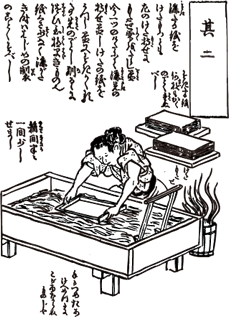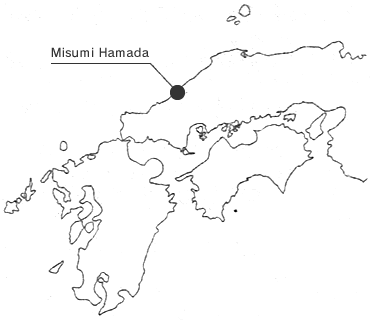Tesuki washi (handmade Japanese paper) was invented in 105 AD by a Chinese official named Cai Lun, and introduced to Japan in 610 AD by Doncho, a Buddhist monk from Korea. Sekishu washi, the special washi paper of western Shimane Prefecture, also has a long history of over a thousand years long. The name Sekishu comes from the Sekishu region (present-day Iwami), where the paper was first produced. The paper is also known as Sekishu-banshi (“half sheets of Sekishu”) because of the cut of the paper.

However, the name Sekishu is probably much older, as Kamisuki Chohoki (A Handy Guide to Papermaking), a book written by Kunisaki Jihei and published in 1798, states that Kakinomoto No Hitomaro, a leading official in the area, taught papermaking skills to the local people sometime around 704-715 AD. From then on, for over 1300 years, the art of handmade washi has been maintained and preserved within the area.
The raw materials for Sekishu washi are kozo, mitsumata, and gampi shrubs. Kozo and mitsumata are cultivated in the region but gampi grows wild. Sekishu-banshi made from Sekishu kozo is well known as the strongest paper produced in Japan. By the Edo period (1603-1867), Sekishu-banshi was popular among Osaka merchants for use in account books, and that name became widely known. Whenever a fire broke out, the merchants did not hesitate to throw their account books into a well to protect the records; the merchants were not worried about the paper being damaged by water.
In light of the unique traditional techniques and methods employed to make Sekishu-banshi by the Sekishu-banshi Craftsmen’s Association, Sekishu-banshi was designated as an Important Intangible Cultural Property in 1969.
In addition, the techniques and methods used for Sekishu-banshi have been completely preserved by the crafts people who live in Misumi Town. To ensure even further improvement of the art, Sekishu Washi Cooperative was established, and Sekishu washi was declared a “Traditional Craft” by the Minister of Economy, Trade and Industry in 1989.
The Sekishu-Banshi papermaking technique was designated as an Important Intangible Cultural Property in 1969, and the Sekishu-Banshi Craftsmen’s Association was recognized as the holding group.
Sekishu-banshi was registered at “the Representative List of the Intangible Cultural Heritage of Humanity” based on the UNESCO Convention for the Safeguarding of the Intangible Cultural Heritage in 2009.
At this time, Sekishu-banshi was reregistered at “the Representative List of the Intangible Cultural Heritage of Humanity” based on the UNESCO Convention for the Safeguarding of the Intangible Cultural Heritage in 2014, as “Washi, craftsmanship of traditional Japanese hand-made paper”.
